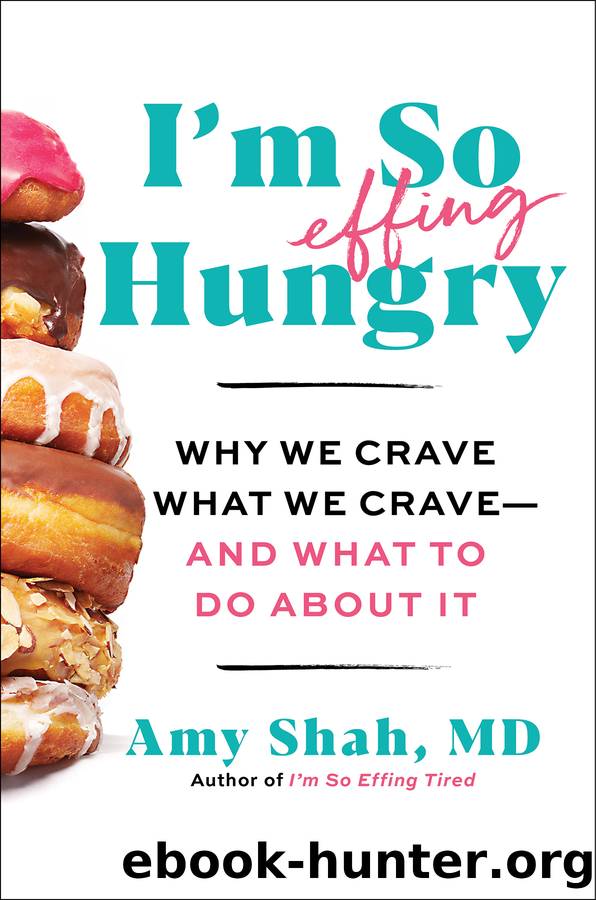I'm So Effing Hungry by Amy Shah

Author:Amy Shah
Language: eng
Format: epub
Publisher: HarperCollins
Published: 2023-02-27T00:00:00+00:00
Practice My 3-2-1 Technique
This technique combines intermittent reward scheduling with certain strategies used in cognitive behavioral therapy (CBT), a form of psychological treatment that works effectively for a range of problems, including depression, anxiety, addictions, eating disorders, and severe mental illness, among others. Unlike many forms of therapy, CBT helps you change faulty or unhelpful ways of thinking. For example, you learn how to recognize distortions in thinking that are creating problems, then change thinking patterns so that they are more in line with reality.
Hereâs a specific example that relates to how you might view food: When you eat a candy bar, how do you normally feel afterward? Happy and content? Or guilty and ashamed?
A lot of people feel bad after eating a candy bar, or something they consider forbidden, and they get upset with themselves. The thought process goes something like: âI ate a bad food; therefore, Iâm a bad person.â This reaction is inaccurate and irrationalâfood is not a moral arbiter of your character. In other words, eating a so-called bad food doesnât make you a bad person, nor does eating a good food make you a good person.
CBT helps you make a psychological shift in your thinking regarding that particular food, so that eating it doesnât cause negative feelings. I read an intriguing study published in the journal Appetite in which participants were asked if they associated chocolate cake more with guilt or with celebration. Those who said they felt guilty after eating chocolate cake had more health issues and problems with motivation than those who associated the cake with celebration. In fact, the guilty eaters felt out of control around food and said they were more likely to overeat.
Hereâs the problem: Feelings of guilt and shame over food only trigger other negative feelings, like helplessness and lack of control, and increase self-criticism. All of these responses can snowball into poor self-esteem, a depressed or anxious mood, and further cravings. Itâs thus important to disassociate negative feelings from food in order to minimize cravings. CBT helps you do that. Next Iâll explain how this works and show you how to practice my 3-2-1 technique. Make sure you read through the instructions entirely before starting the technique to understand how the three components overlap and are used together.
The 3 component. The first week, select three daysâsay, Monday, Wednesday, and Fridayâon which to enjoy a chosen treat, such as two squares of dark chocolate or a couple of oatmeal cookies.
The next week do the same, but on three different days, such as Tuesday, Thursday, and Saturday.
Keep changing the schedule up each week, never following a predictable timeline. This unreliability provides dopamine peaks but without depleting your baseline. By adding the element of uncertainty to the same reward, you maintain a healthy balance of your dopamine levels. The higher the level of unpredictability of a reward, the more you maintain your baseline of dopamine, produce modest peaks, and stop ever-increasing cravings for sweets and junk food.
The 2 component. When you sit down to have a treat, first spend 2 minutes going through the following CBT exercise.
Download
This site does not store any files on its server. We only index and link to content provided by other sites. Please contact the content providers to delete copyright contents if any and email us, we'll remove relevant links or contents immediately.
What's Eating Us by Cole Kazdin(109)
No Apologies by Niamh Orbinski(91)
Recover from Eating Disorders: The Homeodynamic Recovery Method, Step by Step Guide by Gwyneth Olwyn(78)
The Self-Worth Path: A Guided Journey to an Empowered Life by Papez Lisa(70)
Dancing with a Demon by Valerie Foster(65)
I'm So Effing Hungry by Amy Shah(65)
The Predatory Lies of Anorexia by Abby Kelly(64)
The Psychology of Overeating by Kima Cargill(59)
Hope, Help, and Healing for Eating Disorders by Dr. Gregory L. Jantz(55)
Man Up to Eating Disorders by Andrew Walen(52)
Eat with Joy by Stone Rachel Marie;Wirzba Norman;(52)
Think More, Eat Less by Janet Thomson(51)
A Fat Girl's Manifesto by Cyr V. Daniel(51)
Good Girls: a Story and Study of Anorexia by Hadley Freeman(49)
Lessons from the Fat-o-sphere by Kate Harding(47)
The Parent's Guide to Eating Disorders by Jane Smith(43)
Cognitive-Behavioral Treatment of Obesity: A Clinician's Guide by Zafra Cooper Christopher G. Fairburn Deborah M. Hawker(42)
Body in Mind: a New Look at the Somatosensory Cortices : A New Look at the Somatosensory Cortices by Michael Schaefer(41)
Overcoming Anorexia Nervosa by Christopher Freeman(39)
